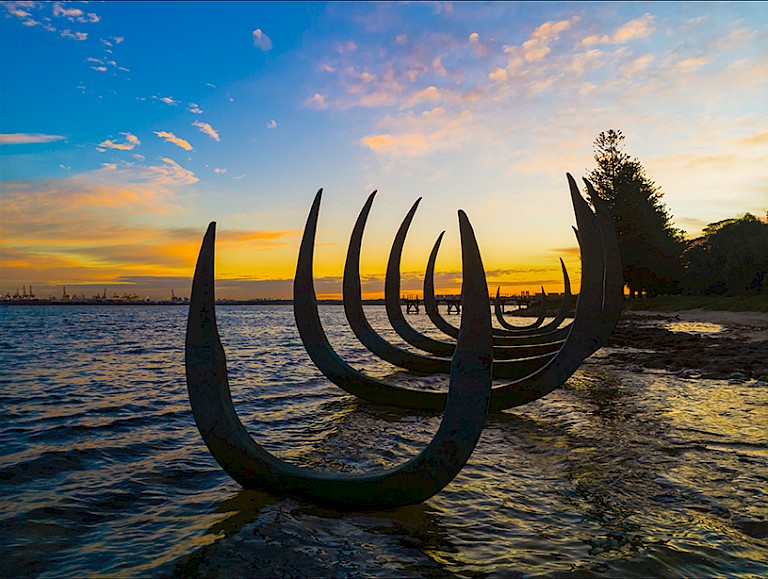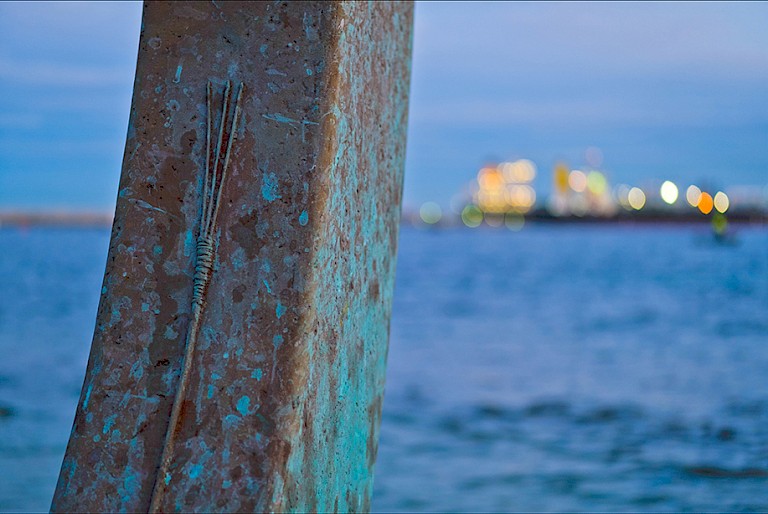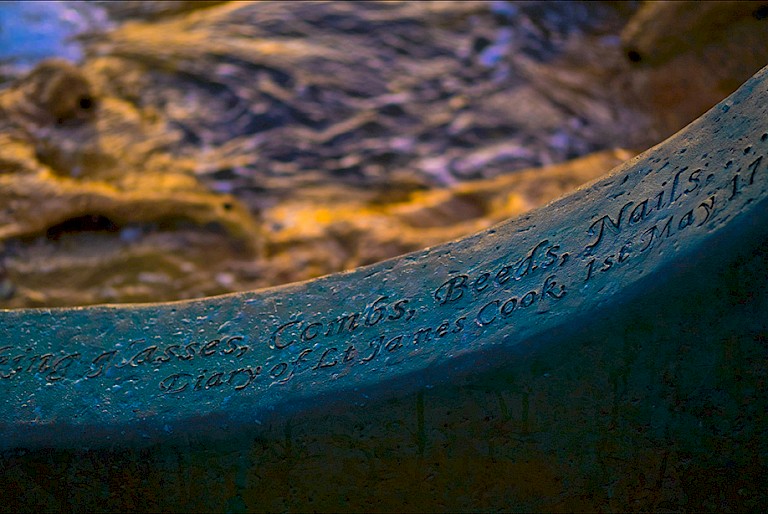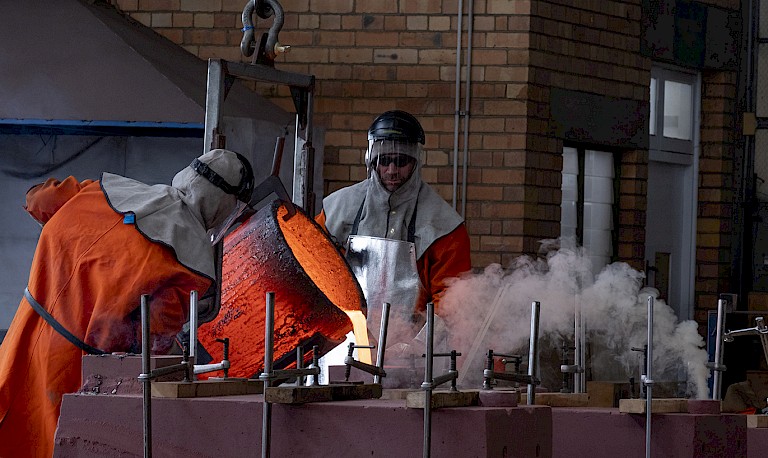



The public art commissioning brief set by New South Wales government to commemorate and interpret the cultural heritage and significance of the place and was commissioned for the 250th anniversary of the meeting between Aboriginal Australians and the Endeavour crew. The Kamay Botany Bay National Park provides a rich multi-faceted site with many layers of significance and it was this location that was chosen for an art work. The Eyes of the Land and the Sea is cast in bronze and takes the form of seven ribs, resembling both the hull of HMB Endeavour, as well as the bones of a whale, being the Gadigal totem. The artists worked closely with the La Perouse Aboriginal community via the Gujaga Foundation to gather local histories and contemporary stories, later cocreating designs for the sculptural artwork. The Gujaga Foundation leads language, cultural and research activities within the La Perouse Aboriginal community. Gujaga works collaboratively with Elders, knowledge holders and leading academics and provides services to educational, cultural and corporate organisations relating to the cultural area of eastern, southern and south western Sydney. Key collaborators from the Gujaga Foundation were Research lead Ray Ingrey, Community Researchers: Kodie Mason, Sophie Youngberry, Academics Dr Paul Irish and Dr Shane Ingrey. The artists also worked with Gweagal artist, Shane Youngberry to develop cultural and historical content etched into each rib describing the 1770 encounters.
A major component of the Kamay 2020 Project (a joint initiative of the Australian Government and NSW Government) was the installation of commemorative sculptures. In February 2019 the Kamay Botany Bay National Park Kurnell Master Plan was endorsed, outlining a number of initiatives designed to reinvigorate the area and enhance its cultural and historical significance. An open tender for artwork submissions began in July 2019, and there was a public exhibition of shortlisted commemorative installations between October—November 2019. The final designs were chosen by the Kamay 2020 Project Board in December 2019.
The Kamay 2020 Project Board considered the public feedback in selecting the successful designs and reflected on how well the designs provided a legacy for future generations to reflect and hear true stories of this important place and the inclusion of Aboriginal representation. The commissioning process was a Government Tender. The National Parks and Wildlife Service sought tenders for the design and construction of a commemorative installation or public art work at Kamay Botany Bay National Park at Kurnell, New South Wales. The tender document stated that the installation or art work was required to commemorate and interpret the cultural heritage and significance of the site and to be completed for the 250th anniversary in April 2020 of the meeting between indigenous Aboriginal Australians and the crew of Lieutenant James Cook’s ship the HMB Endeavour. aka ‘The Meeting Story’. The tender closed at 12pm on 16 July 2019.
A government selection panel was convened, the Kamay 2020 Project Board. Chaired by the Hon. Bruce Baird AM the Project Board was selected by the Commonwealth and NSW Governments to represent stakeholder interest in the project. Other Board members were: Julie Adams; Jason Ardler (Head of Aboriginal Affairs NSW), Greg Holland, Chris Ingrey, La Perouse Local Aboriginal Land Council, The Hon. Dr David Kemp (Chair of the Australian Heritage Council) Dillon Kombumerri (Principal Architect NSW Government Architect) The Hon Ben Morton MP (Assistant Minister to the Prime Minister and Cabinet) Cr Carmello Pesce (Mayor Sutherland Shire Council) The Hon Mark Speakman MP, (Member for Cronulla) The Hon. Robert Webster. Three artist groups were shortlisted into a paid concept round. 2 artwork concepts were commissioned by the Kamay Board. After the winning entry was selected fabrication commenced in December 2019 and work began onsite with footings installed in March 2020. Installation was completed one month later in April 2020.
In their design development document the artists and public art agency UAP state that the installation was located to invite future ferry passengers and current Burrawang Track users to explore the Meeting story and that Page and Lachajczak’s vision will:
1. Honour and respect the Traditional Owners (the Gadigal, Wangal and Cammeraygal, and the peoples of the Eora Nation) and the profound wealth of knowledge they hold.
2. Create new interpretations of cultural heritage and significance of place for local Indigenous communities through extensive community consultation with local La Perouse Indigenous community.
3. Celebrate the wealth of the site’s past and the encourage the creation of new stories for its future.
4. Ensure that the site represents balanced story-telling and create an inclusive space for reflection.
5. Celebrate and frame the spectacular natural environment encouraging returned visitation to the site and memorable experiences.
As a a site-specific sculptural work effort has been put into the art work as a visual reflector of place, and conceptually telling the story of site and reflective of the Australian government push to incorporate Indigenous culture into public spaces. Indigenous architects and artists were selected to lead the redevelopment of the Meeting Place Precinct in Kamay Botany Bay, which also includes an exhibition space at the visitor centre, a cafe, and educational programmes. The Government Architect's office lead the initiative to have Aboriginal knowledge and values incorporated into the construction of urban environments so that local Indigenous people are not just consulted but act as co-designers in the process.
Walbanga and Wadi Wadi woman Alison Page is part of this initiative, along with the local Aboriginal aritst(s) and consultants engaged on The Eyes of the Land and Sea project. There are thoughtfully placed details on the sculpture that directly reference the role this site plays in Australia’s recent history. As the lower portion of the bronze artwork is often covered in salt water with changing tides, a noticeable waterline will develop on the work, embedding the artwork within the site. The uprights, or ‘ribs’ of the sculpture has artwork developed by Gweagal artist Shane Youngberry that references a traditional Gweagal zigzag pattern. A stingray motif is also imprinted on the inside face of every rib, strongly referencing local culture and motifs.
Content inscribed on the ribs focuses on the 8 days that Cook and his men spent at Kamay as seen from both the ship and the shore, referencing how these stories intersect. It represents the juxtaposition of these perspectives from the first encounter on ribs 1 and 2; plants collected by ship botanists Banks and Solander but with their indigenous names (Ribs 3 and 5) and the objects offered and taken by Cook and his men (Ribs 6 and 7). An amalgam of two very different forms, the commemorative installation attempts to speak to the different perspectives of those first encounters, aiming to evoke “a sense of sentiment, mutual understanding, and reflection on the events of 1770”.
Artist Alison Page comments that “The Eyes of The Land and The Sea is a story about discovery. Not the discovery of land by Europeans, but of all Australians discovering their true history as we move together towards a truly reconciled Nation.”
This art work combines ancient and modern Australia’s shared history by integrating the stories from the ship and the shore into a single artwork. The first encounter between James Cook and the First Australians was a meeting of two very different knowledge systems, beliefs and cultures and the abstraction of the ribs of the HMB Endeavour and the bones of the Gweagal totem the whale, are devices the artists intend to speak to the different perspectives of those first encounters, providing a conjoined narrative of two very different world-views. The artists worked closely with the La Perouse Aboriginal community via the Gujaga Foundation to gather local histories and contemporary stories, later cocreating designs for the sculptural artwork, intending the resulting artwork to embed refreshed and revived narratives of history and connection to the land at the Meeting Place, strengthening the significance of the Kamay site to all.
Eyes of the Land and Sea is a striking public art work that in many ways responded to what was a complex brief, complex site, and complex histories. The artists wove indigenous stories and other indigenous artists) into the work at a very early stage and set out to create a “re-appropriation of the bronze statue for truth telling” artist Alison Page stated (Page is also indigenous). In correspondence for this case study Page commented that: “As part of the Black Lives Matter movement there has been a greater focus on true histories and a spotlight particularly on white historical figures that are often portrayed in bronze sculptures. During the BLM protests, many sculptures were defaced and toppled as they commemorated figures involved in slavery and the dispossession of indigenous peoples. The Eyes of the Land and the Sea stands besides an obelisk commemorating Captain James Cook and is a bronze sculpture commemorating the true history of Cook’s Landing in 1770 from a First Nations perspective. It contains a ‘shared perspective;’ the view from the Endeavour ship as well as the view from the shore where my people were hiding in the bushes watching this complex encounter between the two indigenous warriors and Cook.
As such, the art work is a more culturally sound response than many earlier sculptures at the site and part of the AUD$50 million redevelopment reflecting a government push to incorporate Indigenous culture into public spaces. This push was led by the NSW Government Architect's office praising of Aboriginal author Bruce Pascoe's award-winning book Dark Emu in the context of promoting Aboriginal culture in the NSW planning system. Angus Thompson writes how the book “details a pre-existing agricultural economy that was destroyed by Europeans, contributing to a "collective amnesia" about Aboriginal history.” What this art work doesn’t do, however, is reflect on the after effects of that landing/ invasion. Cook’s landing has become a flashpoint for debate around the legacy of colonisation, celebrated by some as the birth of modern Australia and condemned by others as an invasion that marked the beginning of the dispossession of Aboriginal and Torres Strait Islander people.
Australia is embarking on a process of truth telling around its history and the reimagining of historical monuments at sites of significance is an important part of this process” Page has said. Public art specialists and fabricators UAP also describe how the sculpture is “Positioned at the interface of land and sea – the tidal zone that represents the point of first contact where these two worlds initially collided – the work will invite viewers to engage with these diverse stories and enable individual interpretation in regards to what the piece represents for them.” The middle rib of The Eyes of the Land and Sea (Rib 4) is also inscribed with a quote from Cook on his reflections of Aboriginal people, which describes them as the happiest people he has ever witnessed and that the land and sea provide them of all the necessities of life. This quote – while suggesting an understanding and appreciation of indigenous cultural values – seems to play into convenient narratives of the simplicity of indigenous peoples and, in fact, eerily foreshadows what will be taken away from them as the devastating impact of colonisation takes hold. In this way it’s possible to suggest that, like many other public sculptures that express an admirable but over arching desire to reflect history but act as a channel of social cohesion or balm to is most negative side, The Eyes of the Land and Sea glides over important issues of historical truth telling in its desire for reconciliation.
2020 marked the 250th anniversary of Cook’s landing and was (until Covid altered plans) supposed to be marked by a ‘Meeting of Two Cultures’ festival organised by the Sutherland Shire Council and the state government that would see a replica of Cook’s ship Endeavour sent on a voyage around Australia, including dropping anchor in Botany Bay. The meeting of two cultures narrative that guided this art work is certainly more progressive than previous celebrations of Cook’s ‘discovery’ of Australia, but it is tempting to still see it as a superficial one that skims over the impact of this event and doesn’t adequately address historical truth-telling.



